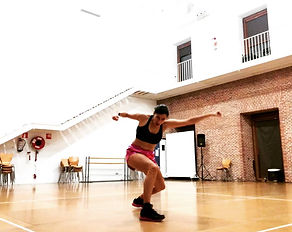top of page


Often works are just a milestone in the depth of a path. This work has taken me to dance in many beautiful places over the last four years. It has had moments of intense love and pain in equal measure, and of joy and humour. A piece in which, besides talking about limits, about laws, about the laws of morality of bodies that enjoy dancing, it has helped me to understand why I dance, from where, why dancing is connected to life and that it is in itself an adventure into the unexpected.
.jpg)


A piece that was never a solo, even though I have spent many hours alone in the studio trying to figure out what the hell moves me (literally) and the mysteries of an arrhythmic beat. In it, I invoke all the people we have ever danced with, all those people with whom we share that moment of intimacy that is dancing, to dance again, together. Those present with those absent. And to summon that moment in which, for a few seconds, we were deeply free.

Spatial practices & choreographic tours ! 2017-20
from the research The construction of performative space
A choreographic tour is a proposal that focuses on the trajectories and flows of bodies as they move from one place to another. It observes the 'paths of desire' or paths of necessity, which are those paths that are made with the footsteps of bodies. It proposes certain approaches in order to rediscover gaps and unconnected, lost or forgotten stories. It is on the basis of the bodies, their movement, their transit that a narrative is constructed or proposed. These tours are based on a work of documentation of the place as well as on experience and observation. Starting from a lack of knowledge of the place, they seek points of fracture from which to activate spaces.


The work I have been developing lately questions and researches the different mechanisms that operate in the construction of performative space. I use architectural and choreographic concepts for this purpose.
In recent years I have developed a series of 'spatial practices' as a methodology of research and creation.
They refer to small performative actions, which are invisible in many cases, and in which the roles between performer and audience are blurred. Their aim is to put the performing bodies in relation to the architecture that surrounds them. They are designed around the question of how everyday norms of use of certain spaces can be broken through small actions.

I believe in a collaborative work based on the understanding of each individual, their needs and desires and behaviour. It's a difficult task. Most of the times we have to deal with failure and miss-understandings. That is why I'm interested in taking those elements as a work element to challenge our own boundaries. As to me, the more important tool is listening, not just humans but everything in this weird and mysterious adventure we call life.

2022 | Performance-Installation. THE RUINS
2021 | Performance. ALLÁ
Installation. DO BODIES DREAM OF ELECTROMAGNETIC ORGANS?
Practice The unknowing machine
Laboratory. INVOCATIONS
Site. From up here
2020 | Site. P.A.S.E. (with María Castillo)
Laboratory. WE (STILL) CAN DANCE
Practice. INVOCATIONS
Texts-action. I don't know
Installation-Publication. BODY MESSAGES
2019 |Performance. WE CAN DANCE
Site. Guided Tour. LCE
Site. Beats & Sweat
Performance. Affect
2018 | Manual: On ways to inhabit this table
& other issues. Installation-Book
2017 |Research. The construction of performative space
Performance. Guided Tour
Esther
Rodriguez - Barbero
bottom of page












.jpg)